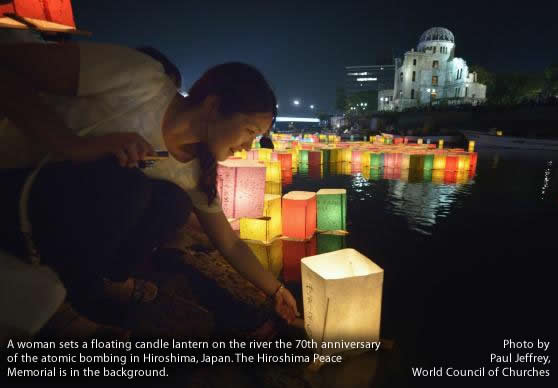Encouraged by a series of arms control agreements beginning with the Reagan administration, nuclear stockpiles have steadily declined since their Cold War high, yet the numbers appear to be slowly rising again. That has prompted a majority of nations to this year support a “humanitarian pledge” to institute a legal ban on such weapons, just as the world has outlawed chemical and biological weapons, as well as cluster bombs and land mines.
Swenson, once arrested herself at a site in the Nevada desert where U.S. nuclear weapons were tested, called it a critical moment, ripe for faith communities to urge their governments to support the humanitarian pledge to stop nuclear weapons.
 Joining Christians in Japan
Joining Christians in Japan
The ecumenical delegation was invited by the Christian churches of Japan, which have long spoken against the proliferation of nuclear weapons, and remain a leading voice in resisting the remilitarization of Japan today.
In both cities, Swenson, who is vice moderator of the WCC’s central committee, and her colleagues took part in ecumenical worship services. In front of a packed crowd in a Catholic cathedral in Hiroshima, Swenson preached the sermon — the first time someone other than a male Anglican or Catholic priest had done so.
Wherever the delegation traveled, local church leaders introduced the visitors to hibakusha–the Japanese term for those who survived the atomic bombings.
“Hiroshima and Nagasaki are sacred places, but tragically many people don’t know that until they’ve come here to meet with ordinary people and hear the stories of the hibakusha,” said Archbishop Nathaniel Makoto Uematsu, primate of the Anglican Church in Japan and one of the delegation’s hosts.
In Hiroshima, Swenson said she was particularly moved by her meeting with Koko Kondo, a 70-year old hibakusha whose adventures left the delegation alternately laughing and crying. Kondo’s father was a Methodist pastor, but most of his congregation was killed in the atomic blast.
In Nagasaki, Swenson said she was captivated by listening to Sumiteru Taniguchi, an 86-year old bombing survivor. “He was working as a postman and was knocked off his bike by the blast, burned horribly and spent years in the hospital recovering. We saw photos of his body back then, but we heard him tell his story now. His life is a powerful testament to peace,” she added.
Taniguchi is chair of the Nagasaki Atomic Bomb Survivors Council, and in a speech to the city’s main anniversary ceremony he criticized Japanese government proposals that would allow the country to renege on its post-war commitment to peace.
“The security bill the government is pursuing will lead to war,” declared Taniguchi, whose speech was met with enthusiastic applause. “We cannot accept this.”
Japan’s nationalist prime minister, Shinzo Abe, also addressed the crowd. Although Abe proclaimed that Japan would lead the movement to ban nuclear weapons—something he’d been criticized for not stating at the ceremony in Hiroshima three days earlier—abolitionists and many of Japan’s neighbors don’t trust him.
Nagasaki’s mayor, Tomihisa Taue, appealed to Abe at the ceremony to explore “national security measures which do not rely on nuclear deterrence.”
Willingness to ‘acknowledge the sins’
Japan’s churches have set a tone for national repentance in recent years by publicly recognizing their complicity with war crimes committed by the Japanese military during World War II. It hasn’t been a popular move, as Abe and other conservative politicians have resisted any discussion of Japanese wrongdoing.
Early on Aug. 9, the WCC delegation took part in a memorial ceremony remembering the Korean forced laborers who been brought by the Japanese to work as slaves in Nagasaki. Along with several U.S. prisoners of war and other foreigners in the city, they died when the plutonium bomb exploded at 1,650 feet over the city.
“I’m grateful for the willingness of the Japanese church and the Japanese people to acknowledge the sins they committed,” Swenson said. “Koko Kondo started her conversation with us by talking about what the Japanese had done to other people, and she expressed her apology for that.
“Her voice and her story are a powerful demand to stop making nuclear weapons, made even more so by her honesty about the horrors her own government supported.”
Bishop Swenson said United Methodists have a lot to learn from their Christian sisters and brothers in Japan.
“We need to speak the truth about the horrors we have supported,” she said. “That’s what Bishop Elaine Stanovsky is trying to do around the Sand Creek Massacre. We need to do more of that, whether it’s Sand Creek or Hiroshima, as a way to begin the healing process for all.”
The Rev. Paul Jeffrey is a United Methodist missionary journalist. He accompanied the WCC delegation to Hiroshima and Nagasaki.
